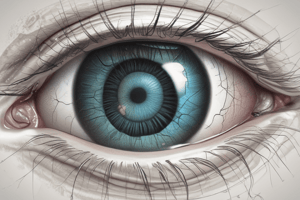Podcast
Questions and Answers
What type of visual field defect is seen in a lesion to the center of the chiasm?
What type of visual field defect is seen in a lesion to the center of the chiasm?
- Central VFD
- Bitemporal hemianopsia (correct)
- Homonymous hemianopsia
- Junctional scotoma
Which of the following lesions causes a central VFD in one eye and a partial temporal VFD in the opposite eye?
Which of the following lesions causes a central VFD in one eye and a partial temporal VFD in the opposite eye?
- Lesion to the proximal fibers of an ON and the nasal fibers of the opposite eye (correct)
- ON lesion
- Lesion to the optic radiations
- Lesion to the optic tract
What is the term for a visual field defect that affects one side of the visual field in both eyes?
What is the term for a visual field defect that affects one side of the visual field in both eyes?
- Central VFD
- Homonymous hemianopsia (correct)
- Bitemporal hemianopsia
- Junctional scotoma
Which lobe is associated with an inferior quadrantanopsia?
Which lobe is associated with an inferior quadrantanopsia?
What type of lesion causes a homonymous hemianopsia?
What type of lesion causes a homonymous hemianopsia?
What is the term for a visual field defect that affects the upper quadrant of the visual field?
What is the term for a visual field defect that affects the upper quadrant of the visual field?
Which condition is associated with a central VFD?
Which condition is associated with a central VFD?
What type of lesion causes a bitemporal hemianopsia?
What type of lesion causes a bitemporal hemianopsia?
Which condition is associated with an altitudinal VFD?
Which condition is associated with an altitudinal VFD?
What type of lesion causes a junctional scotoma?
What type of lesion causes a junctional scotoma?
What is the normal range of a single eye's visual field in degrees?
What is the normal range of a single eye's visual field in degrees?
Where is the physiological blind spot located in relation to the eye being evaluated?
Where is the physiological blind spot located in relation to the eye being evaluated?
What is the primary function of the central visual field?
What is the primary function of the central visual field?
What is the range of the temporal visual field in degrees?
What is the range of the temporal visual field in degrees?
What is the term for the loss or defect of the visual field that may be the only sign of a lesion in the visual pathway?
What is the term for the loss or defect of the visual field that may be the only sign of a lesion in the visual pathway?
What is the primary function of the peripheral visual field?
What is the primary function of the peripheral visual field?
What is the range of the nasal visual field in degrees?
What is the range of the nasal visual field in degrees?
What is the term for the type of visual field defect that occurs when there is a lesion in the optic nerve?
What is the term for the type of visual field defect that occurs when there is a lesion in the optic nerve?
What is the range of the superior visual field in degrees?
What is the range of the superior visual field in degrees?
What is the term for the type of visual field defect that occurs when there is a lesion in the chiasm?
What is the term for the type of visual field defect that occurs when there is a lesion in the chiasm?
What type of visual field defect is associated with optic nerve lesions?
What type of visual field defect is associated with optic nerve lesions?
What is the common cause of a right complete homonymous hemianopsia?
What is the common cause of a right complete homonymous hemianopsia?
What type of visual field defect is often associated with pituitary gland tumors?
What type of visual field defect is often associated with pituitary gland tumors?
What is the characteristic of a pre-chiasmal altitudinal defect?
What is the characteristic of a pre-chiasmal altitudinal defect?
What type of lesion would cause a visual field defect in the left side of both eyes?
What type of lesion would cause a visual field defect in the left side of both eyes?
What type of visual field defect is characterized by a loss of half of the visual field in one eye?
What type of visual field defect is characterized by a loss of half of the visual field in one eye?
What is the term for a visual field defect that affects the same half of the visual field in both eyes?
What is the term for a visual field defect that affects the same half of the visual field in both eyes?
What type of lesion is typically associated with a bitemporal hemianopsia?
What type of lesion is typically associated with a bitemporal hemianopsia?
What is the term for a circular area of depressed vision surrounding the point of fixation?
What is the term for a circular area of depressed vision surrounding the point of fixation?
What is the term for a visual field defect that affects the peripheral vision?
What is the term for a visual field defect that affects the peripheral vision?
What is the primary function of the peripheral visual field?
What is the primary function of the peripheral visual field?
What is the location of the physiological blind spot in relation to the eye being evaluated?
What is the location of the physiological blind spot in relation to the eye being evaluated?
What is the range of the temporal visual field in degrees?
What is the range of the temporal visual field in degrees?
What is the primary function of the central visual field?
What is the primary function of the central visual field?
What is the range of the inferior visual field in degrees?
What is the range of the inferior visual field in degrees?
What type of visual field defect is often associated with lesions to the proximal fibers of an optic nerve and the nasal fibers of the opposite eye?
What type of visual field defect is often associated with lesions to the proximal fibers of an optic nerve and the nasal fibers of the opposite eye?
What type of lesion causes a homonymous hemianopsia?
What type of lesion causes a homonymous hemianopsia?
What type of visual field defect is seen in patients with retinitis pigmentosa?
What type of visual field defect is seen in patients with retinitis pigmentosa?
What type of lesion causes an inferior quadrantanopsia?
What type of lesion causes an inferior quadrantanopsia?
What type of visual field defect is seen in patients with anterior ischemic optic neuropathy (AION)?
What type of visual field defect is seen in patients with anterior ischemic optic neuropathy (AION)?
What type of visual field defect is seen in patients with strokes (CVA) or traumatic brain injury (TBI)?
What type of visual field defect is seen in patients with strokes (CVA) or traumatic brain injury (TBI)?
What is the purpose of confrontation visual fields (CVF) and finger counting fields (FCF)?
What is the purpose of confrontation visual fields (CVF) and finger counting fields (FCF)?
What is the term for a visual field defect that affects the same half of the visual field in both eyes?
What is the term for a visual field defect that affects the same half of the visual field in both eyes?
What is the characteristic of a post-chiasmal altitudinal defect?
What is the characteristic of a post-chiasmal altitudinal defect?
What is the term for a circular area of depressed vision surrounding the point of fixation?
What is the term for a circular area of depressed vision surrounding the point of fixation?
What is the term for a visual field defect that affects the upper quadrant of the visual field?
What is the term for a visual field defect that affects the upper quadrant of the visual field?
What is the characteristic of a congruous visual field defect?
What is the characteristic of a congruous visual field defect?
What type of visual field defect is often associated with glaucoma?
What type of visual field defect is often associated with glaucoma?
Flashcards
Visual Field Defect (VFD)
Visual Field Defect (VFD)
A loss of vision in a specific area of the visual field, caused by damage to the visual pathway.
Central VFD
Central VFD
Loss of vision in the central 30 degrees of vision, often affecting the central part of the visual field.
Peripheral VFD
Peripheral VFD
Loss of vision in the outer parts of the visual field.
Hemianopia
Hemianopia
Signup and view all the flashcards
Quadrantanopia
Quadrantanopia
Signup and view all the flashcards
Altitudinal VFD
Altitudinal VFD
Signup and view all the flashcards
Pre-chiasmal lesion
Pre-chiasmal lesion
Signup and view all the flashcards
Chiasmal lesion
Chiasmal lesion
Signup and view all the flashcards
Post-chiasmal lesion
Post-chiasmal lesion
Signup and view all the flashcards
Scotoma
Scotoma
Signup and view all the flashcards
Congruous VFD
Congruous VFD
Signup and view all the flashcards
Incongruous VFD
Incongruous VFD
Signup and view all the flashcards
Study Notes
Visual Field Defects
- A lesion in the visual pathway can cause visual field defects (VFDs) which can be classified into different types based on their location and shape.
Types of Visual Field Defects
- Central VFD: a defect in the central 30 degrees of vision, often seen in optic neuritis, macular hole, cone dystrophy, BRAO, and BRVO.
- Peripheral VFD: a defect in the peripheral vision, often seen in retinitis pigmentosa, BRVO, BRAO, hysterical amblyopia, and Streff Syndrome.
- Hemianopia: a defect in half of the visual field, often seen in strokes (CVA), traumatic brain injury (TBI), and intracranial mass.
- Quadrantanopia: a defect in a quarter of the visual field, often seen in strokes (CVA), traumatic brain injury (TBI), and intracranial mass.
- Altitudinal VFD: a defect above or below the horizontal meridian, often seen in anterior ischemic optic neuropathy (AION), compressive neuropathy, BRAO, BRVO, papilledema, and disc edema.
Visual Pathway Lesions
- Lesions in the visual pathway can cause different types of VFDs:
- Pre-chiasmal lesions: monocular ipsilateral defect (e.g., macular hole, retinal detachments, glaucomatous changes, optic atrophy, or optic neuropathy).
- Chiasmal lesions: bitemporal hemianopsia (e.g., tumor compressing pituitary gland or aneurysm of the anterior communicating artery).
- Post-chiasmal lesions: homonymous hemianopsia (e.g., stroke, traumatic brain injury, or intracranial mass).
Visual Field Evaluation
- Confrontation Visual Fields (CVF) and Finger Counting Fields (FCF) are methods used to evaluate the visual field.
- Automated perimetry and tangent screens are more detailed methods used to evaluate the visual field.
- Visual field defects can be categorized as congruous (symmetric) or incongruous (asymmetric).
Terminology
- Depression/Constriction: a general reduction in overall sensitivity of the visual field.
- Scotoma: an area of depressed vision surrounded by an area of less depressed or normal vision.
- Shallow or Relative Scotoma: an area of the retina that is not sensitive to relatively dim stimuli but is sensitive to brighter/lighter stimuli.
- Deep or Absolute Scotoma: no response to a stimulus regardless of brightness or size.
Studying That Suits You
Use AI to generate personalized quizzes and flashcards to suit your learning preferences.




